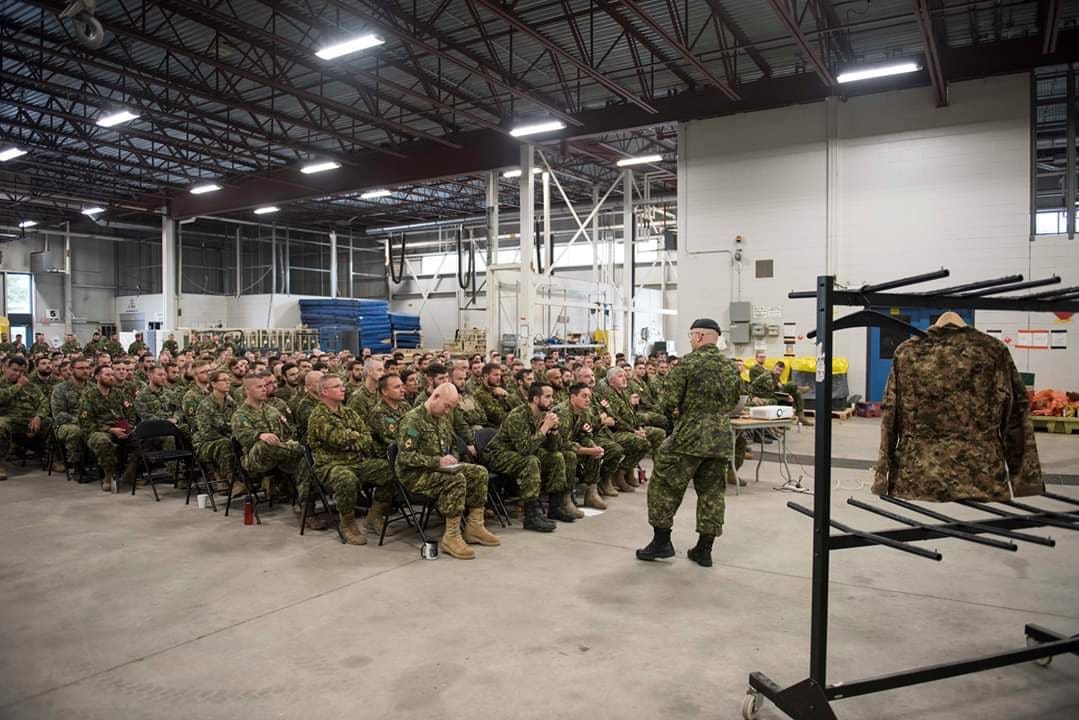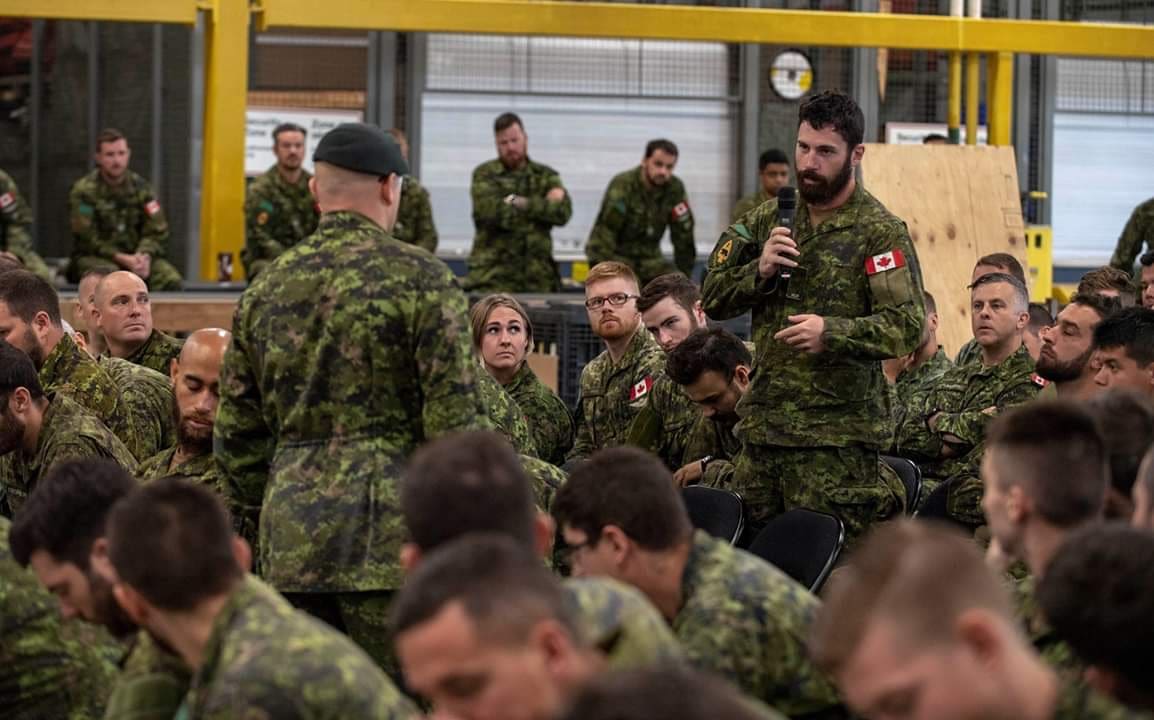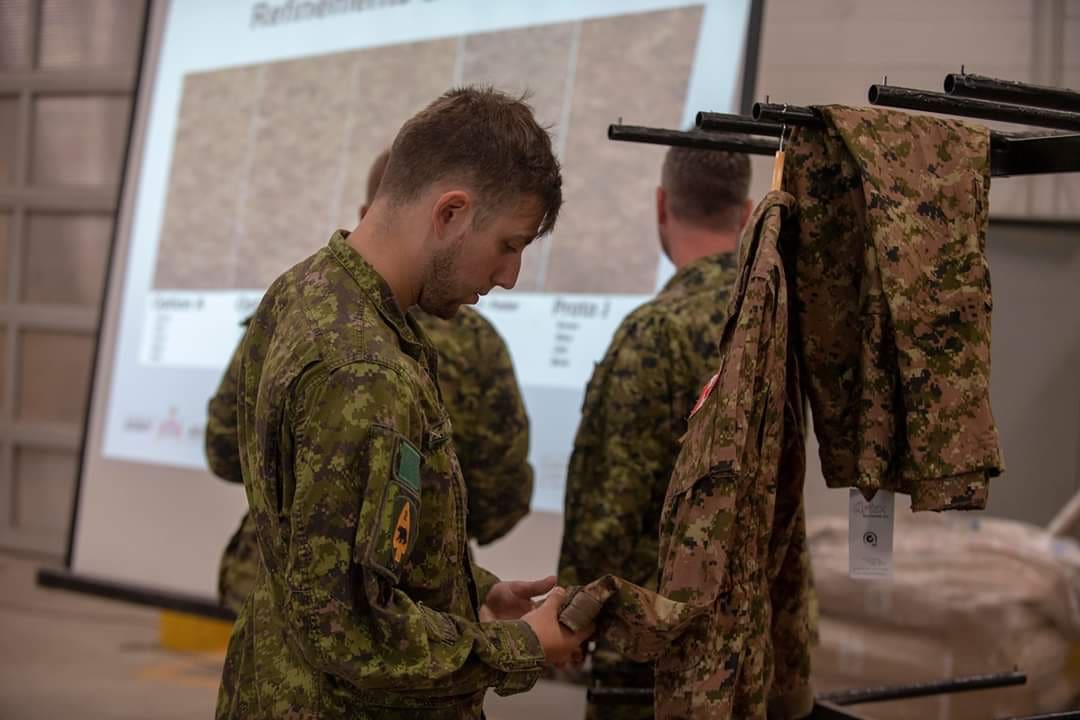
Lieutenant-Colonel Raymond Corby speaks to 3rd Battalion, The Royal Canadian Regiment, about the Soldier Clothing and Equipment Modernization Trial at Garrison Petawawa on September 4, 2019. Photo By: Private Robert Kingerski PA01-2019-0286
Ottawa, Ontario — Some 600 soldiers at 4th Canadian Division Support Base (4 CDSB) Petawawa will soon be standing out as they help the Canadian Armed Forces test a new Canadian Disruption Pattern (CADPAT) to help select a replacement camouflage for the current iconic woodland and arid CADPAT patterns.
The original distinctive CADPAT, revolutionary for its time, was initially developed in 1997. It is most closely associated with the Canadian Army but it is also worn by Navy and Air Force personnel when they work within Army lines.
Canadian Special Operations Forces personnel wear another pattern, MultiCam, which is not being replaced.
Since CADPAT was issued, there have been a number of advances made in camouflage research, specifically protection from detection by infra-red and other night vision systems.
Starting at the end of September 2019, 3rd Battalion, The Royal Canadian Regiment will begin wearing coats and trousers, shell fragmentation protective body armor, bush caps, helmet covers and rank patches in the “Prototype J” mid-spectrum pattern.
This new four-colour pattern falls in the middle of the camouflage spectrum, not overly emphasizing brown or green tones.

A member of 3rd Battalion, The Royal Canadian Regiment, asks a question to Lieutenant-Colonel Raymond Corby about the Soldier Clothing and Equipment Modernization Trial at Garrison Petawawa on September 4, 2019. Photo By: Able Seaman Elizabeth Ross PA02-2019-0286-007
While there have been over a dozen patterns tested, this is the first pattern to be taken out of a lab and tested using real soldiers, who are undergoing rigorous training for overseas operations. There will likely be adjustments made to the pattern resulting from this trial.
The trial will last until July 2020. During this time, the Human Factors Support Cell from the Soldier Systems Directorate within Director General Land Equipment Program Management will seek user feedback about the “Prototype J” pattern by conducting large-scale questionnaires.
The team will also conduct data collection, focus groups, and 3D body scanning to define how the current operational uniform and personal equipment can be improved.
This study will also include seeking out soldiers of smaller stature, including but not exclusively women, to ensure that the next generation of clothing and equipment fit the widest variety of soldiers possible.

A member of 3rd Battalion, The Royal Canadian Regiment, inspects the prototype uniform from the Soldier Clothing and Equipment Modernization Trial at Garrison Petawawa on September 4, 2019. Photo By: Able Seaman Elizabeth Ross PA02-2019-0286-012
The Soldier Operational Clothing and Equipment Modernization (SOCEM) project, led by the Canadian Army Director of Land Requirements, in cooperation with Assistant Deputy Minister (Materiel) and Defence Research and Development Canada, has been working for over two years on harnessing technological advances to improve the functionality of Canadian Armed Forces operational uniforms and equipment.
The goal is operational clothing and equipment that protect and fit better while lightening the load carried by soldiers.
Transitioning to a single pattern from the current temperate woodland (green), and arid (tan) will also create efficiencies in terms of logistics.
With the final decision expected no later than 2022 and a full roll out 2027, the interim years will see mixed uniforms and equipment as items in the new pattern are gradually acquired and put into service.
By Eric De Lafontaine, Manager – Soldier Operational Clothing and Equipment Modernization, Directorate of Soldier Systems Program Management


Gong show
Oh Canada, why the cheap out? Go with MULTICAM, as it works and is a NATO Standard pattern.
Our SOF already used multicam, gotta differentiate
Even the US Army didn’t want to shell out the licensing money to Crye so it’s unlikely DGLEPM would consider that option.
Nothing wrong with looking Canadian. The US, Aus and UK all wear copies of multicam so they don’t have to pay royalties
In May 2011, Australia paid $7.8 million USD to Crye Precision for their own Australian Multicam Pattern. https://www.smh.com.au/national/new-defence-uniforms-on-the-way-20110530-1fcay.html
The Crye deal with the British is confidential as is the one with New Zealand. According to my last discussion with one of the printers in the U.S., Crye still gets a royalty for Scorpion-W2 printing for the U.S. Military.
Some of the countries have opted to buy the exclusive rights to the pattern from Crye but it is not free. Most countries that use a Crye pattern do so with a license.
Guy is right – none of those countries are getting “freebies”. All of their patterns were all developed in cooperation with Crye, and license fees were paid accordingly. The initial deal for the British MTP was reported as something like 2.6M GBP to develop MTP and issue it as an Urgent Operational Requirement for Afghanistan, as I recall. When it later became the new standard issue pattern for all of the UK forces I don’t recall seeing any public info about any alterations to that deal.
I also understand that Crye is getting some kind of royalty amount under the confidential terms of the settlement between Crye and the US government for the use of Scorpion W2.
If larger patterns tested better for the US4CES series, why not adapt something similar? Is this change just a middle ground for the existing patterns?
I’m excited to see what UCP should have been.
Kinda looks like Universal AOR!
Transitional AOR, not far off…
It is close to AOR-Universal, but with black. Check out page 6 of this:
http://www.hyperstealth.com/Hyperstealth-Summary-Canadian-Forces-camouflage-change-to-Multicam.pdf
It’s similar to several of the DG3 patterns.
http://octactical.homestead.com/dg3comp6.jpg
8 years to roll out what is essentially the UCP-Delta pattern…
That’s a negative, I don’t see urban gray or foliage gray in this.
I have pants in UCP-D: this isn’t even the same sport.
Why on earth would Canada go for multicam for everyone? It is way too light for their country. People are just obsessed with a pattern that is beyond overrated. It is very limited and too far toward arid in its usability. Great it works well in fields and some areas in home country but it’s not a good choice for most countries. The fact that spec ops everywhere use it is irrelevant, they are doing urban stuff and it’s just a matter of coarse to use it.
What are the odds we will be in the Middle East in quantity soon?
Pretty dang good we will be there. Better odds than not being there in quantity.
Actually Multicam works really well in the vast majority of Canadian terrain and in desert environments. This is an attempt to create a universal pattern to make a single uniform, with Canadian content.
The CF keeps quoting that there are zero manufacturers of Multicam uniforms in Canada, despite the factory set up to manufacture uniforms for CANSOFCOM
Thanks for the Hyperstealth Report link, Stike Hold. That’s one of the best summaries I read in a while, and it’s pretty nuts and bolts. He gets after it.
Doesn’t look too far off from that Russian SURPAT camo. Shame to see CADPAT TW go away though, that’s a really cool pattern.
I’d rather take the current CADPAT TW or AR but update it in either Crye G3 field cut and clothing material or the new US Army jungle uniform. There is nothing wrong with CADPAT.
Just go with Multicam like the rest of the 5 eyes countries…sort of makes sense.
CADPAT, revolutionary for its time? Certainly was when the Germans were wearing something similar in WW2. It’s just a copy of Flecktarn!
This is why I want out. We can’t afford multi cam but we can afford 100 plus generals that make 200k plus a year and make wicked awsome calls like this